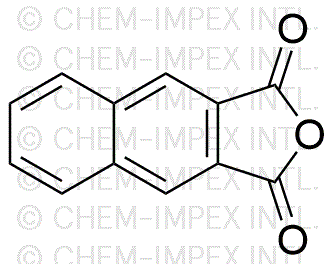2,3-Naphthalenedicarboxylic anhydride is widely utilized in research focused on:
- Polymer Production: This compound serves as a key intermediate in the synthesis of high-performance polymers, such as polyimides, which are used in electronics and aerospace applications due to their thermal stability and mechanical strength.
- Dyes and Pigments: It is used in the formulation of dyes and pigments, providing vibrant colors and excellent lightfastness, making it ideal for textiles and coatings.
- Pharmaceuticals: The compound plays a role in the development of pharmaceutical intermediates, contributing to the synthesis of various medicinal compounds that target specific health conditions.
- Chemical Intermediates: It acts as a versatile building block in organic synthesis, allowing researchers to create complex molecules efficiently, which is crucial in developing new materials and chemicals.
- Research Applications: In academic and industrial research, it is used to study reaction mechanisms and develop new synthetic pathways, enhancing the understanding of chemical reactivity and properties.
Informations générales
Propriétés
Sécurité et réglementation
Applications
2,3-Naphthalenedicarboxylic anhydride is widely utilized in research focused on:
- Polymer Production: This compound serves as a key intermediate in the synthesis of high-performance polymers, such as polyimides, which are used in electronics and aerospace applications due to their thermal stability and mechanical strength.
- Dyes and Pigments: It is used in the formulation of dyes and pigments, providing vibrant colors and excellent lightfastness, making it ideal for textiles and coatings.
- Pharmaceuticals: The compound plays a role in the development of pharmaceutical intermediates, contributing to the synthesis of various medicinal compounds that target specific health conditions.
- Chemical Intermediates: It acts as a versatile building block in organic synthesis, allowing researchers to create complex molecules efficiently, which is crucial in developing new materials and chemicals.
- Research Applications: In academic and industrial research, it is used to study reaction mechanisms and develop new synthetic pathways, enhancing the understanding of chemical reactivity and properties.
Documents
Fiches de données de sécurité (FDS)
La FDS fournit des informations de sécurité complètes sur la manipulation, le stockage et l’élimination du produit.
Spécifications du produit (PS)
Le PS fournit une description complète des propriétés du produit, notamment sa composition chimique, son état physique, sa pureté et les exigences de stockage. Il détaille également les plages de qualité acceptables et les applications prévues du produit.
Certificats d'analyse (COA)
Recherchez des certificats d'analyse (COA) en saisissant le numéro de lot du produit. Les numéros de lot et de lot se trouvent sur l'étiquette d'un produit, après les mots « Lot » ou « Lot de fabrication ».
Numéro de catalogue
Numéro de lot/série
Certificats d'origine (COO)
Ce certificat d'exploitation confirme le pays dans lequel le produit a été fabriqué, et détaille également les matériaux et composants utilisés et s'il est issu de sources naturelles, synthétiques ou autres sources spécifiques. Ce certificat peut être requis pour les douanes, le commerce et la conformité réglementaire.
Numéro de catalogue
Numéro de lot/série
Fiches de données de sécurité (FDS)
La FDS fournit des informations de sécurité complètes sur la manipulation, le stockage et l’élimination du produit.
DownloadSpécifications du produit (PS)
Le PS fournit une description complète des propriétés du produit, notamment sa composition chimique, son état physique, sa pureté et les exigences de stockage. Il détaille également les plages de qualité acceptables et les applications prévues du produit.
DownloadCertificats d'analyse (COA)
Recherchez des certificats d'analyse (COA) en saisissant le numéro de lot du produit. Les numéros de lot et de lot se trouvent sur l'étiquette d'un produit, après les mots « Lot » ou « Lot de fabrication ».
Numéro de catalogue
Numéro de lot/série
Certificats d'origine (COO)
Ce certificat d'exploitation confirme le pays dans lequel le produit a été fabriqué, et détaille également les matériaux et composants utilisés et s'il est issu de sources naturelles, synthétiques ou autres sources spécifiques. Ce certificat peut être requis pour les douanes, le commerce et la conformité réglementaire.


